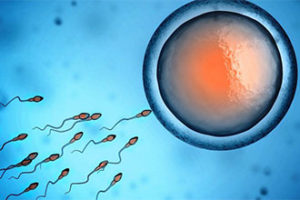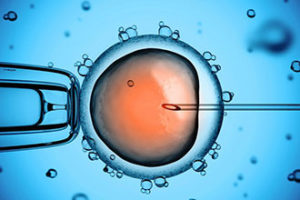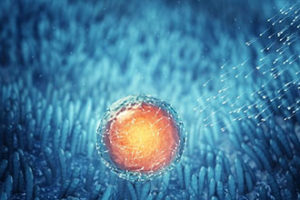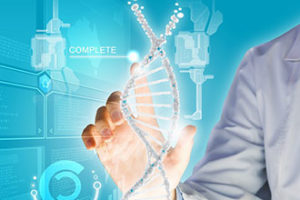Artificial insemination
 The pregnancy of a surrogate mother comes as a result of an IVF procedure. This abbreviation stands for “in vitro fertilization”, that is, the embryo is obtained by fusion of the spermatozoon and oocyte (ovum) outside the woman’s body in the laboratory. Often this modern medical technology is used as a method of treating infertility.
The pregnancy of a surrogate mother comes as a result of an IVF procedure. This abbreviation stands for “in vitro fertilization”, that is, the embryo is obtained by fusion of the spermatozoon and oocyte (ovum) outside the woman’s body in the laboratory. Often this modern medical technology is used as a method of treating infertility.
In surrogacy programs IVF allows the use of the biological material of a couple that wish to have a child. Similarly, a baby is born, which is genetically connected with the parents, and hereditary traits are transmitted to him. A surrogate mother has no kinship with the nurtured child, therefore she is usually called a “gestational courier”.
During the first stage of such a program the menstrual cycles of the two women – biological and surrogate mothers – are synchronized. Then, the ovaries of the biological mother are stimulated and the follicles are punctured to receive oocytes. Simultaneously, the state of the endometrium (inner ball of the uterus) of the surrogate mother is monitored.
After sampling the sperm of the biological father in the laboratory, the ovum is fertilized. The obtained embryos are cultivated for several days in a special nutrient medium. If necessary, the procedure of pre-implantation genetic diagnosis is conducted. Then the embryo is transferred to the uterine cavity of the surrogate mother.
Using a frozen embryo
 It is possible to use an embryo after cryopreservation. Such embryos often remain after a couple passes through IVF protocols. SurMom Surrogacy Center provides services for the delivery of embryos from the country of residence of biological parents to the country where the surrogate mother is located and where her artificial insemination will take place.
It is possible to use an embryo after cryopreservation. Such embryos often remain after a couple passes through IVF protocols. SurMom Surrogacy Center provides services for the delivery of embryos from the country of residence of biological parents to the country where the surrogate mother is located and where her artificial insemination will take place.
Modern technologies of freezing biological material (sperm, eggs, embryos) allow us to fully preserve its viability for many years. There were cases when pregnancy began after the use of an embryo frozen 10 or more years ago. According to statistics, cryopreserved embryos do not reduce the chances of IVF success.
Earlier, the embryos underwent a “slow” freezing procedure for storage. Contact with liquid nitrogen could lead to the formation of ice crystals that damage the structure of cells. As a result, about 25-30% of the embryos were unsuitable for further use. Now specialists apply a more modern method of cryopreservation.
Vitrification (“fast freezing”) excludes the possibility of the formation of ice crystals inside the cells of the embryo. Freezing occurs rapidly. The liquid instantly passes into the vitreous state without passing through the crystallization stage. Experts at SurMom Company recommend using cryopreserved embryos if they are available.
Donation of the ovum
 The company has an extensive database of oocyte donors in different countries. Requirements for women who are ready to sacrifice their biological material are no less strict than to surrogate mothers. Each of them preliminarily undergoes extensive medical and psychological screening. All procedures strictly comply with the legislation of the country in which they are carried out.
The company has an extensive database of oocyte donors in different countries. Requirements for women who are ready to sacrifice their biological material are no less strict than to surrogate mothers. Each of them preliminarily undergoes extensive medical and psychological screening. All procedures strictly comply with the legislation of the country in which they are carried out.
According to the generally accepted requirements in the world, ovum donors can be women aged 25-32 with a good general state of health and reproductive system. To obtain oocytes, they previously undergo the procedure of ovarian hyperstimulation. In the period preceding taking the oocytes, constant monitoring of the growth of the follicles is made. Ova are removed by puncturing the ovaries.
SurMom Surrogacy Center gives clients the opportunity to choose an ovum donor among 2-3 candidates. The women’s CVs are sent to the future parents by e-mail. The questionnaire contains not only information about external data, but also about age, education, hobbies, sexual orientation and religion, all of which helps the future parents make the best choice.
The donor’s ovum can be used in the surrogate mother’s IVF protocol, and also undergo the procedure of cryopreservation and be stored until the necessary time. SurMom Company cooperates with the best clinics of reproductive medicine abroad that ensures complete safety and efficiency of the use of donor ovum.
Preimplantation genetic diagnosis
 The PGD method makes it possible to exclude hereditary diseases in the embryo. This is the most modern way of detecting genetic/chromosomal abnormalities before placing the embryo in the uterus. It is advisable to apply it in cases when biological parents are aware of the presence of inherited pathologies.
The PGD method makes it possible to exclude hereditary diseases in the embryo. This is the most modern way of detecting genetic/chromosomal abnormalities before placing the embryo in the uterus. It is advisable to apply it in cases when biological parents are aware of the presence of inherited pathologies.
Such high-tech diagnostics enables the identification of abnormalities that lead to the development of Down syndrome, hemophilia, Duchenne muscular dystrophy and a number of other dangerous diseases. In addition, this method allows you to learn about the future child’s sex. However, this practice is prohibited by law in a number of countries.
The essence of preimplantation genetic diagnosis is in the retrieval of 1-2 blastomeres (cells) in the embryo. It is carried out three days after fertilization, when the embryo consists of six to eight cells. At this stage of development, all cells of the embryo are completely equivalent. The extraction of cells does not subsequently influence the development of the embryo; it continues its normal growth.
Another option for implementing the PGD method is a biopsy of the outer cell layer of the embryo (trophectoderm). This examination is carried out on the fifth day of the embryo’s development. The method of comparative genomic hybridization is used to analyze the state of blastomere’s nuclei. SurMom Company attracts the best laboratory resources for such research.

